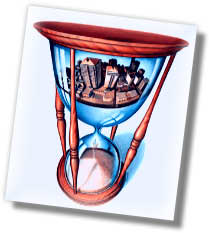|
Every single day, factories, farms, and houses in Canada use about
136,380 million L (30,000 million gallons) of water. Most of it is clean and
unpolluted, but we are using it up at a fast rate. Though the total amount
of water in the world remains the same, the form it takes and the way it is
spread around the Earth is changing. For example, some of North America's groundwater
comes from underground aquifers that are filled with ancient fossil water that
fell many years ago. Rainfall patterns have now changed since the water first
seeped into the ground, so there is not enough rain to fill the aquifers as fast
as they are being pumped out. Aquifers that are empty take an extremely long time
to be filled. One rare possibility is that the empty aquifer may collapse and not be
able to collect fresh water ever again.
Not only are the aquifers becoming empty, but surface water may disappear
because of global warming. Water supplies such as wells can be prevented from
running dry if we start conserving now.
Wasting water has two strikes against it. It uses up our fresh water, and adds
more dirty water to our overworked hydrologic cycle. The less often we use water
unnecessarily, the less water goes down the drain and back to the treatment plant,
and the less chlorine is added to the water system.
|

|

